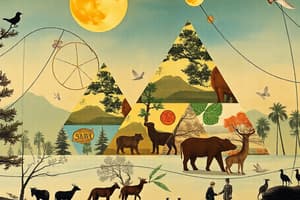Podcast
Questions and Answers
Give one example of a food chain that exists in nature.
Give one example of a food chain that exists in nature.
A rabbit eats grass, a fox eats the rabbit, a wolf eats the fox.
In an ecological pyramid, what happens to energy, biomass, and number of species as you move up? Why?
In an ecological pyramid, what happens to energy, biomass, and number of species as you move up? Why?
They all decrease because energy is lost as it moves up each trophic level.
What is biomass?
What is biomass?
Biomass is renewable energy from plants and animals.
In an ecosystem, can there be more carnivores than herbivores? Explain why or why not.
In an ecosystem, can there be more carnivores than herbivores? Explain why or why not.
What is the 10% rule? What is its significance? Why is energy lost?
What is the 10% rule? What is its significance? Why is energy lost?
List two human activities that interfere with ecosystems, food chains, and food webs.
List two human activities that interfere with ecosystems, food chains, and food webs.
Discuss what trophic level humans can occupy on an ecological pyramid and explain biomagnification.
Discuss what trophic level humans can occupy on an ecological pyramid and explain biomagnification.
Who eats the sedge?
Who eats the sedge?
Flashcards are hidden until you start studying
Study Notes
Food Chains and Ecosystems
- A food chain example: grass is eaten by rabbits, rabbits by foxes, and foxes by wolves.
- Energy, biomass, and number of species decrease as you move up an ecological pyramid due to energy loss at each trophic level.
Energy Transfer and Biomass
- Biomass is the organic matter derived from plants and animals, serving as renewable energy.
- The 10% rule signifies that only 10% of energy is transferred between trophic levels, leading to significant energy loss.
Carnivores and Herbivores
- There must be more herbivores than carnivores in an ecosystem to ensure sufficient food supply for carnivores, preventing population collapse.
Human Impact on Ecosystems
- Human activities like overhunting and overfishing disrupt ecosystems, food chains, and food webs.
Trophic Levels and Contaminants
- Humans can occupy various trophic levels, excluding producers and decomposers, functioning as heterotrophs.
- Biomagnification is the process where contaminants, like mercury, accumulate in higher concentrations in organisms at higher trophic levels.
Sedge in the Food Web
- Sedge, a coarse grass, serves as a food source for grasshoppers and chickens in the ecosystem.
Studying That Suits You
Use AI to generate personalized quizzes and flashcards to suit your learning preferences.





